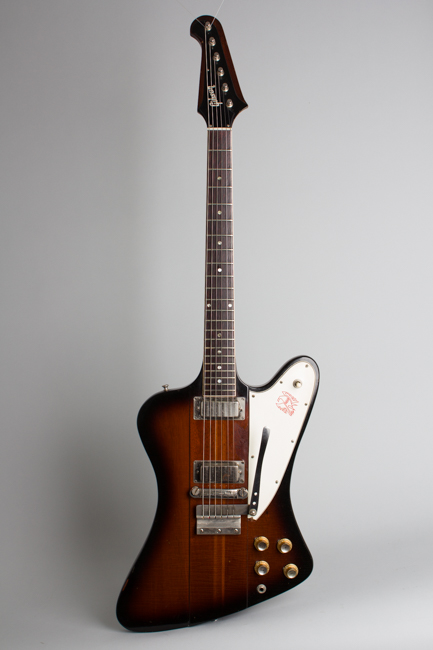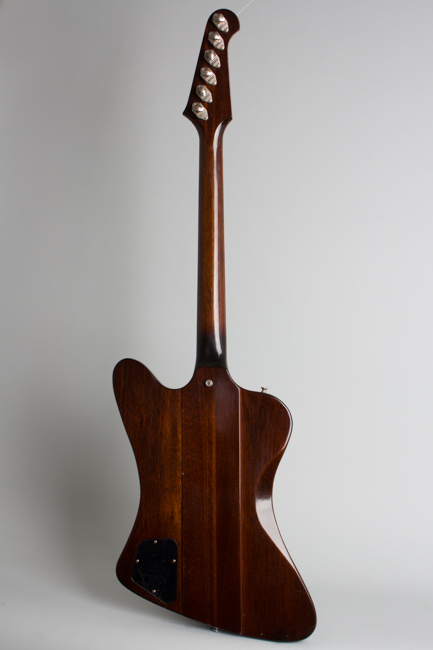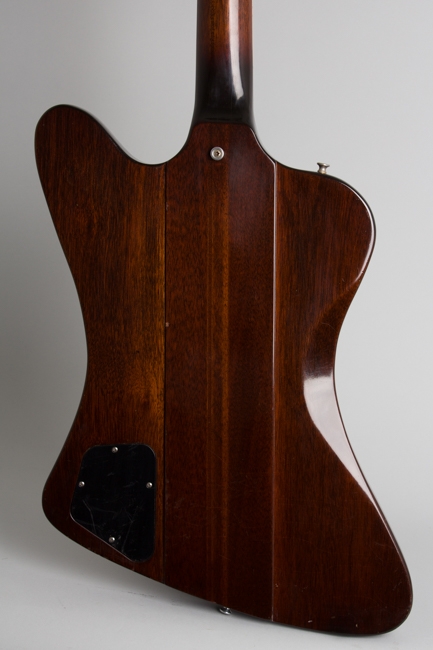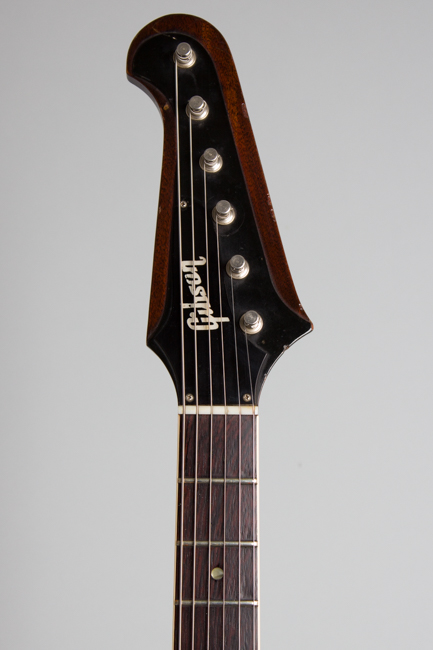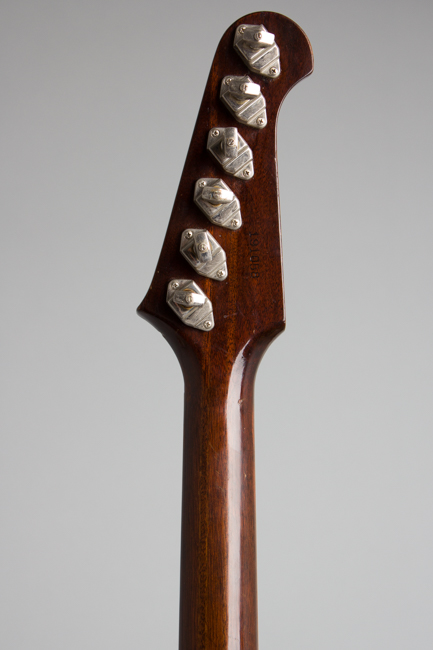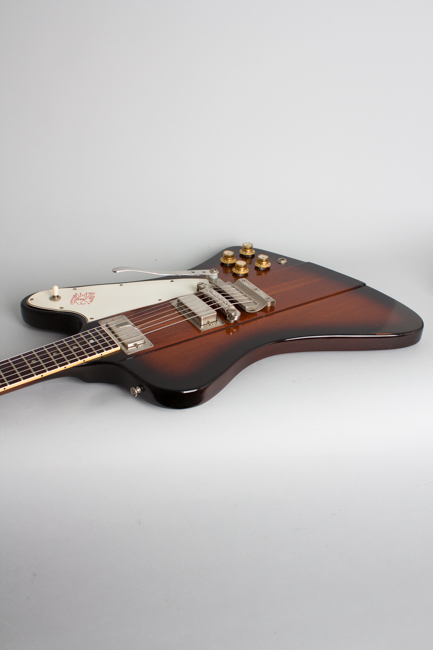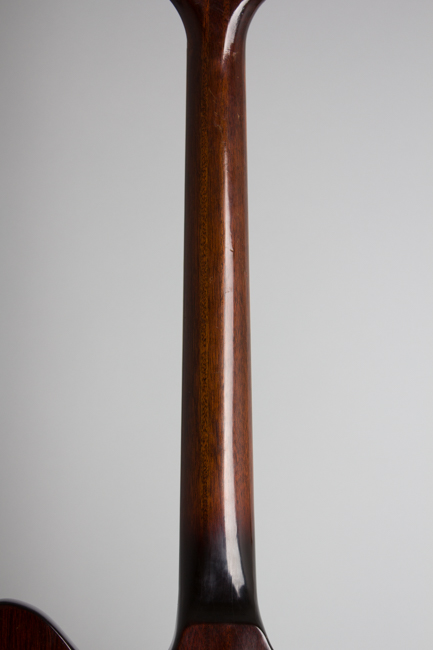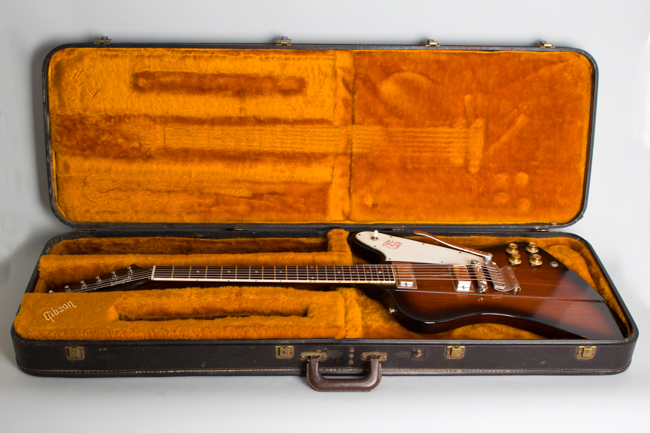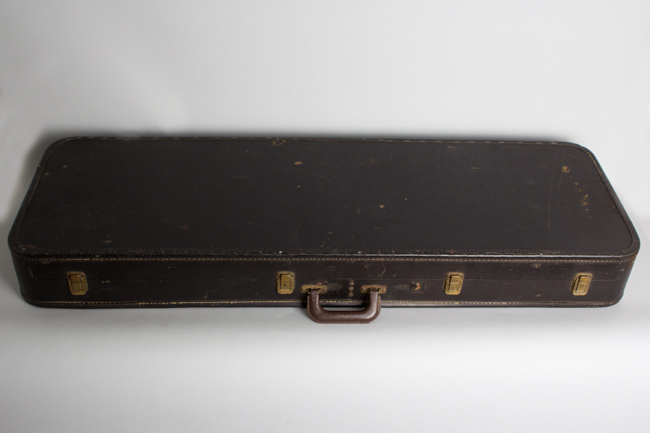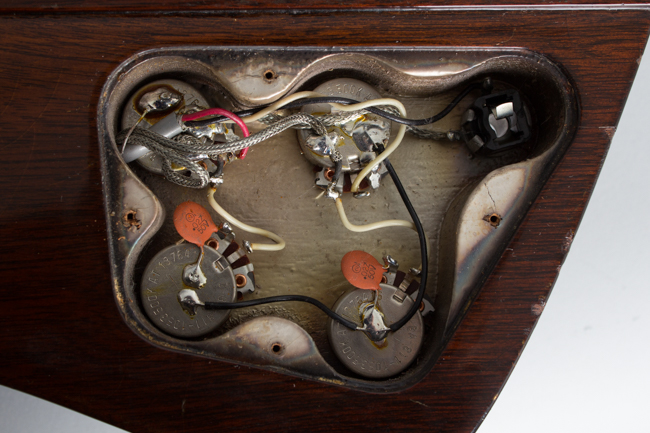Gibson Firebird III Solid Body Electric Guitar (1964)
This item has been sold.
Item # 10105
Prices subject to change without notice.
Gibson Firebird III Model Solid Body Electric Guitar (1964), made in Kalamazoo, Michigan, serial # 191058, sunburst lacquer finish, laminated mahogany body and neck, rosewood fingerboard, original black tolex hard shell case.
This is a definitely played but still super cool 1964 example the most popular original "reverse" body Firebird model, the Firebird III. This entire instrument line was originally quite short-lived, introduced in late 1963 and discontinued after the mid-1965 NAMM show. The original pattern Firebird is considered a Gibson classic with its futuristic sweeping lines and innovative through-body neck construction, but the limited production time meant they barely had a chance to get established in the market before being replaced by the more conventional "non-reverse" version. The originals have been a sought-after guitar since, re-issued, revamped but never really equaled in the Gibson pantheon.
The Firebird III was the mid-line model in the original line of 'birds. This one has pots coded 137 6414, so was likely built around mid-1964. The bound, dot inlaid fingerboard is the defining element of the III model as much of the hardware and layout is otherwise shared with the next model up, the Firebird V. Other fittings include two special mini-humbucking pickups, a short Vibrola tailpiece with the "spoon" trem arm and solid stud bridge and the unique "backwards" headstock with individual Kluson banjo tuners. All hardware is nickel plated. The pickguard covers just the lower horn and carries the selector switch; it is also decorated with a nifty Firebird emblem. The neck is bigger than the contemporary SG series with a relatively chunky feeling but comfortable round-backed profile; this one is a bit slimmer than some.
Practically everything about the original Firebirds was unique; the long laminated neck-through-body centerpiece with "wings" glued to the sides, the fluid body shape with the longer lower cutaway horn and that headstock with the tuner buttons hidden from the front and the low E farthest from the nut. They hardly had a chance to establish themselves in the market before being drastically revamped. A threatened lawsuit from Fender is often cited as the reason, but more likely the complex design simply proved uneconomical to produce. The elaborate sculpting of the body and headstock and neck-through construction make for a beautiful instrument but was difficult for Gibson to build on a cost-effective basis, especially compared to Fenders with their bolt-on necks.
Despite use with a number of major bands of the day (including the Rolling Stones. Four Seasons, Merseybeats and briefly the Lovin' Spoonful) these beautiful birds flew off into oblivion way too quickly. It's estimated that about 2000 of the original "Reverse" Firebird III were produced between late '63 and mid '65; many have suffered cracks in the headstock area and/or been played heavily or modified. This all-original 'bird is a splendid survivor, showing some wear but still a great all-around guitar with a unique and powerful sound.
Overall length is 45 in. (114.3 cm.), 13 1/2 in. (34.3 cm.) wide at lower bout, and 1 1/8 in. (2.9 cm.) in depth, measured at side of rim. Scale length is 24 3/4 in. (629 mm.). Width of nut is 1 11/16 in. (43 mm.).
This guitar shows some play wear but remains all original with no major damage, repairs, or alterations. The most common Firebird malady is fully absent -- the neck has NEVER been cracked or broken. There is one spot of fairly heavy wear to the face, below the strings above the top edge of the pickguard. The wood is worn away a bit on the edge of the raised centerpiece, the most likely explanation is the original owned used metal fingerpicks. Apart from this the finish shows light checking and the usual assortment of small chips, scuffs and dings, mostly on the edges. There is some heavier scuffing on the back on and by the control cavity plate, but overall the instrument is not otherwise heavily worn.
There is some typical pickguard shrinkage with the screws pulling at corners, and the lower point cracked off. The screw at that spot has been moved slightly inwards to compensate. The engraved and painted bird emblem on the pickguard is very well preserved, far better than most with virtually all the paint intact. The nickel plating shows typical wear but remains largely intact. The only changed parts are slightly larger period screws holding on the truss rod cover, which has the upper tip cracked off. The "Volume" marking is worn off the uppermost knob, and it looks like someone made a half-hearted effort to scratch the other one off as well.
The guitar is original and complete down to the oft-missing "spoon" vibrato arm, which still has the original mounting screw and nylon bushings. The frets and fingerboard show some light wear and this is an excellent player, with the typical snarly Firebird sound. It includes the black rectangular original case, externally original but elaborately re-lined inside with new bracing and deep plush to better support the instrument. While not the most perfectly clean Firebird we have seen lately, this must have had an interesting life so far and remains a great sounding and playing example of this super stylish if eccentric Gibson classic. Overall Excellent - Condition.
This is a definitely played but still super cool 1964 example the most popular original "reverse" body Firebird model, the Firebird III. This entire instrument line was originally quite short-lived, introduced in late 1963 and discontinued after the mid-1965 NAMM show. The original pattern Firebird is considered a Gibson classic with its futuristic sweeping lines and innovative through-body neck construction, but the limited production time meant they barely had a chance to get established in the market before being replaced by the more conventional "non-reverse" version. The originals have been a sought-after guitar since, re-issued, revamped but never really equaled in the Gibson pantheon.
The Firebird III was the mid-line model in the original line of 'birds. This one has pots coded 137 6414, so was likely built around mid-1964. The bound, dot inlaid fingerboard is the defining element of the III model as much of the hardware and layout is otherwise shared with the next model up, the Firebird V. Other fittings include two special mini-humbucking pickups, a short Vibrola tailpiece with the "spoon" trem arm and solid stud bridge and the unique "backwards" headstock with individual Kluson banjo tuners. All hardware is nickel plated. The pickguard covers just the lower horn and carries the selector switch; it is also decorated with a nifty Firebird emblem. The neck is bigger than the contemporary SG series with a relatively chunky feeling but comfortable round-backed profile; this one is a bit slimmer than some.
Practically everything about the original Firebirds was unique; the long laminated neck-through-body centerpiece with "wings" glued to the sides, the fluid body shape with the longer lower cutaway horn and that headstock with the tuner buttons hidden from the front and the low E farthest from the nut. They hardly had a chance to establish themselves in the market before being drastically revamped. A threatened lawsuit from Fender is often cited as the reason, but more likely the complex design simply proved uneconomical to produce. The elaborate sculpting of the body and headstock and neck-through construction make for a beautiful instrument but was difficult for Gibson to build on a cost-effective basis, especially compared to Fenders with their bolt-on necks.
Despite use with a number of major bands of the day (including the Rolling Stones. Four Seasons, Merseybeats and briefly the Lovin' Spoonful) these beautiful birds flew off into oblivion way too quickly. It's estimated that about 2000 of the original "Reverse" Firebird III were produced between late '63 and mid '65; many have suffered cracks in the headstock area and/or been played heavily or modified. This all-original 'bird is a splendid survivor, showing some wear but still a great all-around guitar with a unique and powerful sound.
Overall length is 45 in. (114.3 cm.), 13 1/2 in. (34.3 cm.) wide at lower bout, and 1 1/8 in. (2.9 cm.) in depth, measured at side of rim. Scale length is 24 3/4 in. (629 mm.). Width of nut is 1 11/16 in. (43 mm.).
This guitar shows some play wear but remains all original with no major damage, repairs, or alterations. The most common Firebird malady is fully absent -- the neck has NEVER been cracked or broken. There is one spot of fairly heavy wear to the face, below the strings above the top edge of the pickguard. The wood is worn away a bit on the edge of the raised centerpiece, the most likely explanation is the original owned used metal fingerpicks. Apart from this the finish shows light checking and the usual assortment of small chips, scuffs and dings, mostly on the edges. There is some heavier scuffing on the back on and by the control cavity plate, but overall the instrument is not otherwise heavily worn.
There is some typical pickguard shrinkage with the screws pulling at corners, and the lower point cracked off. The screw at that spot has been moved slightly inwards to compensate. The engraved and painted bird emblem on the pickguard is very well preserved, far better than most with virtually all the paint intact. The nickel plating shows typical wear but remains largely intact. The only changed parts are slightly larger period screws holding on the truss rod cover, which has the upper tip cracked off. The "Volume" marking is worn off the uppermost knob, and it looks like someone made a half-hearted effort to scratch the other one off as well.
The guitar is original and complete down to the oft-missing "spoon" vibrato arm, which still has the original mounting screw and nylon bushings. The frets and fingerboard show some light wear and this is an excellent player, with the typical snarly Firebird sound. It includes the black rectangular original case, externally original but elaborately re-lined inside with new bracing and deep plush to better support the instrument. While not the most perfectly clean Firebird we have seen lately, this must have had an interesting life so far and remains a great sounding and playing example of this super stylish if eccentric Gibson classic. Overall Excellent - Condition.
